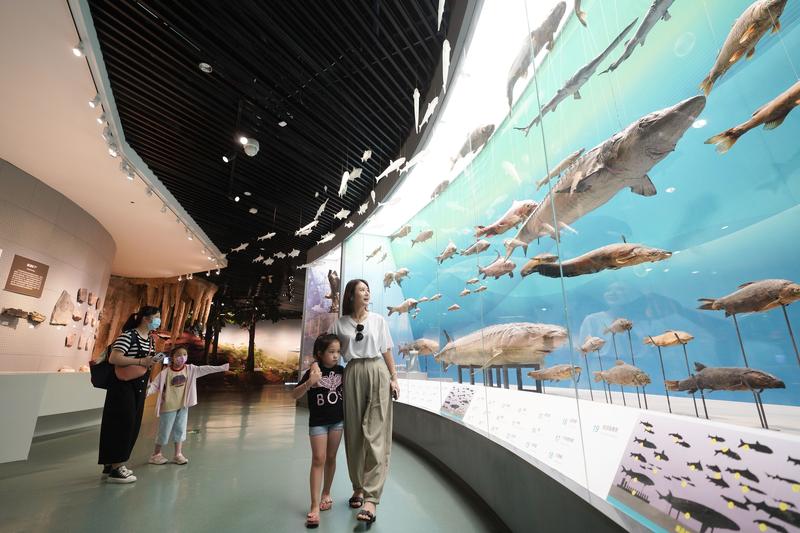 Parents and children visit the marine exhibition at the Chongqing Museum of Natural History in August. (QIN TINGFU / XINHUA)
Parents and children visit the marine exhibition at the Chongqing Museum of Natural History in August. (QIN TINGFU / XINHUA)
Museums can be an expansion to schools and better benefit elementary and high school students' growth, a new national guidance policy shows.
The Ministry of Education and the National Cultural Heritage Administration co-released a document on Monday to illustrate a better use of museum resources for the school sector.
As the document states, schools are urged to design new activities related to history, natural science and technology, based on collections in local museums. Syllabuses of courses like Chinese, history, geography, fine arts, physics, chemistry, biology, among others, will include museum content. Various educational goals will be set for students in different grades.
More extracurricular activities after 3:30 pm are encouraged to feature museums, according to the document. Not only guided tours to venues, but also creative formats like lectures, role-play games, and comic books on museums, are needed to increase student interest.
Training programs for teachers will involve relevant content, and better coordination concerning different departments of local governments will follow to ensure financial support and proper evaluation of the educational activities related to museums.
"We've seen many good examples of making full use of museums as 'classes' in recent years," Luo Jing, director of the museum and social relics department of the National Cultural Heritage Administration, explains. "And it matches the needs of school education to explore the resources of museums on a deeper level."
Luo points out that the new document aims to develop new channels making use of museums in school education.
"The focus remains on how to help students study better at school," Luo says. "But the museum-related activities can be more interactive, attractive and immersive."
He also expects the upcoming activities to be able to better nurture student "patriotism".
The booming development of Chinese museums in recent years has created a foundation for better integration of museums into the school syllabus, Pan Shouyong, a museology professor at Shanghai University, tells China Daily.
According to the statistics of the National Cultural Heritage Administration, 5,535 museums had been registered on the Chinese mainland by the end of 2019. Pan estimated that the actual total number could be around 7,000 if it includes the museums affiliated to universities and other institutions, which are not independent legal entities.
And 76 percent of China's county-level administrative regions had at least one museum.
According to administration statistics, over the past five years, minors accounted for 260 million visits annually to Chinese museums on average, about 20 percent of the total number of visits. And 203 museums nationwide have been included on the list of "research and study bases" for juveniles.
"As visiting museums has become commonplace in the lives of Chinese people, it's natural that such guidance was issued," Pan says. "Many after-school training institutions have chosen museums as their venues to launch educational programs. It's great to see more schools attending, and a nationwide effort also means better program planning.
In China's revised evaluation and ranking system on museums, which went into effect in January, an institution will get a bonus if its operation council includes a member who is in charge of education programs.
"In the past, though organized tours to museums were often regular occurrences for many elementary and high schools, the impetus was on the side of the school and the teachers," Pan recalls. "And museums lacked full participation.
"But the situation is more demanding now," he says. "Museum operators need to cooperate with schools to design courses and even textbooks. When drawing constructional blueprints for new museums, more spaces for children's education and classrooms will also be put into consideration."
Nevertheless, the professor admits that the work cannot be done overnight. A problem is that the number of museums specializing in natural history in China are still outweighed by their counterparts focusing on human history, which could be a challenge when designing syllabuses in smaller cities.
"Museums can be places for children to comprehensively expand their horizons of knowledge, nurture their artistic tastes and improve their sense of aesthetics," Pan says. "It's a good start to see a nation-level framework, but it cannot only be a fad. A long-term interaction between museums and schools will have lasting benefits."


